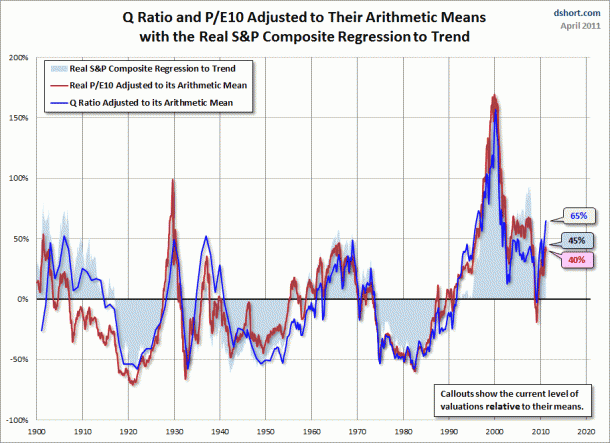
As highlighted today by my colleague Houses and Holes, a growing number of commentators — most recently Richard “Balance Sheet Recession” Koo — are weighing in on on the folly of quantitative easing and the risk that it poses for asset prices. The main charge is as follows. As The Bernank himself has hinted at a number of times, one of the main aims of QE was to reflate equity prices, which, in turn, was supposed to lead to a virtuous circle of greater consumer confidence and spending, a revival of credit, and so on and so forth. But what if the huge rebound in asset prices has outpaced the improvement in the economy’s fundamentals? Are we now facing a Wiley E Coyote type moment with our legs spinning in thin air on the edge of a cliff?
Here’s what Koo has to say:
Viewed objectively, the central banks are trying to push up asset prices using quantitative easing and the portfolio rebalancing effect. The resultant rise in asset prices based on this effect represented a potential bubble—or at least a liquidity-driven event—from the start.
The question is whether the real economy can keep pace with asset prices formed in those liquidity-driven markets. If it cannot, higher asset prices will be considered a bubble and will collapse at some point. The resulting situation could be much more severe than if quantitative easing had never been implemented to begin with.
…if stock and commodity prices are in fact in a bubble and if those bubbles were to collapse, the balance sheets of the financial institutions and hedge funds making investments with the expectation of higher asset prices could suffer heavy damage, exacerbating the balance sheet recession in the broader economy.
In his recent quarterly letter, Jeremy Grantham (who is on quite a roll of late) made a similar argument, advising his clients to start lightening up on risk assets and stating that “the environment has simply become too risky to justify prudent investors hanging around, hoping to get lucky.”
Simply put, the prospective returns from the stock market (in developed markets) in coming years are so miserly that they do not sufficiently compensate for the multitude of risks that we face today.
Now, the perennially optimistic investment banks may still have a “constructive” view on growth and asset prices, but as readers of MacroBusiness will be familiar with, the global economy today faces a number of risks. To rattle off just a few, the possibility of a sharp growth slowdown in China, ongoing sovereign debt woes in Europe, rising oil prices, not to mention the recent turmoil at the IMF. Despite all these risks, stock prices have continued to power higher in 2011. And this is a direct result of QE.
In the words of the fund manager John Hussman:
The effect of QE has been to increase valuations – producing high short-run returns by borrowing from long-term prospects. This has now produced a degenerate menu of long-term investment options (for passive investment strategies).
Quantitative easing cannot produce wealth – it can only shift the profile of returns from the future to the present by forcing all assets to compete with zero-return cash. Now that it has done so, it is urgent for investors to weigh the prospective returns that remain, against the likely long-term risks.
In other words, we are borrowing from the future. And according to this view, even if QE3 were to eventuate and push markets higher, we would only be setting ourselves up for an even bigger crash in the future.
With respect to the prospective returns from the stockmarket, Hussman states:
The stock market continues to be strenuously overvalued here, with a variety of historically reliable methods indicating probable total returns for the S&P 500 of only about 3.5% over the coming decade.
Now, keep in mind that these are nominal returns, so if Hussman is right, he is saying that after adjusting for inflation, real returns will be close to zero over the coming decade. Obviously if you are in the camp that expects inflation to spiral out of control, you would expect even worse real returns on stocks.
Indeed, valuations today certainly do look stretched. The following chart from Doug Short suggests that, depending on which metric you choose, US stocks are overvalued by somewhere between 40% and 65%.

This raises some uncomfortable questions for proponents of the passive “buy and hold” equity story. If prospective returns really are so low for the coming decade or more, a smarter approach is probably needed.
So what’s an investor to do? Grantham’s guess is probably as good as anyone’s:
Investors should take a hard-nosed value approach … having substantial cash reserves around a base of high quality blue chips and emerging market equities, both of which have semi-respectable real imputed returns.
My very long-term personal recommendations remain the same: forestry and good agricultural land, “stuff in the ground,” and resource efficiency plays.
Should commodities crash in the near term because of good weather, problems in China, or both, I think it will create another “investment opportunity of a lifetime,” much like the several we have had in recent years.
In other words, this could be a good time to keep your powder dry.
————————————————
Note: Please read the disclaimer on financial advice in the menu bar above.